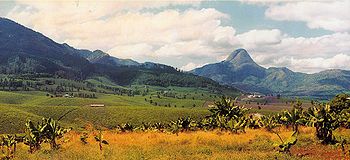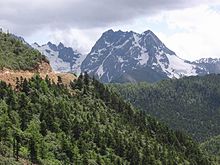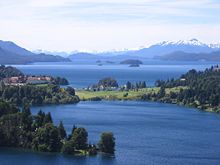
Landscape
About this schools Wikipedia selection
This selection is made for schools by a children's charity read more. SOS mothers each look after a a family of sponsored children.

Landscape comprises the visible features of an area of land, including the physical elements of landforms such as (ice-capped) mountains, hills, water bodies such as rivers, lakes, ponds and the sea, living elements of land cover including indigenous vegetation, human elements including different forms of land use, buildings and structures, and transitory elements such as lighting and weather conditions.
Combining both their physical origins and the cultural overlay of human presence, often created over millennia, landscapes reflect the living synthesis of people and place vital to local and national identity. Landscapes, their character and quality, help define the self-image of a region, its sense of place that differentiates it from other regions. It is the dynamic backdrop to people’s lives.
The Earth has a vast range of landscapes including the icy landscapes of polar regions, mountainous landscapes, vast arid desert landscapes, islands and coastal landscapes, densely forested or wooded landscapes including past boreal forests and tropical rainforests, and agricultural landscapes of temperate and tropical regions.
Landscape may be further reviewed under the following specific categories: landscape art, cultural landscape, landscape ecology, landscape planning, landscape assessment and landscape design.
Etymology
The question of the various meanings which 'Landscape' has acquired from the Middle Ages till present times is not just a question of etymological curiosity; it reflects, among others, the history of conflicts between local and centralized power in emerging European nation-states (a subject discussed in depth by Kenneth Olwig in publications listed in the Reference List) and also changing approaches to landscape within Geography and within the Arts. Moreover, the story of the various meanings of the English word landscape makes up an interesting example of " dynamic construal" of meaning.
It is widely accepted in the literature that "In Europe the concept of landscape and the words for it in both Romance and Germanic languages emerged around the turn of the sixteenth century to denote a painting whose primary subject matter was natural scenery (Punter 1982; Cosgrove 1993)"
It should be noted though that the Northern European concept of landscape appeared centuries earlier than the 19th and that it carried then, and continues to carry, meanings that go far beyond natural scenery. 'It is believed that the words land, landscipe or landscaef entered the English language some time after the 5th century; these terms referred to a system of human-made spaces on the land.
Olwig argues that the substantive importance of the landscape concept is easier to understand when the word is broken down for separate analysis into land and –scape and then reconstituted .
Taking first land: Land (a word from Germanic origin) may be taken in its sense of something to which people belong (as in England being the land of the English, (likewise Finland, Ireland, Poland). The 'land of a people' was historically divided into smaller lands, which might belong to a communality (e.g. the common lands belonging to the village community) or to a figure seen to represent or embody the land (e.g. the lands of the prince). (Another meaning of the term land refers to a material substance as in "an area of ground" (Oxford English Dictionary, 1971;in the following:OED).
On the suffix -scape:
- 'Landscape' is distinguished from 'land' by the suffix -scape, which is equivalent to the more common English suffix -ship. The roots of –ship are etymologically akin to Old English sceppan or scyppan, meaning to shape (Merriam-Webster dict.2000. This suffix designates "something showing, exhibiting or embodying a quality or state"; as such, it generates an abstraction upon the term landscape. The suffix -ship thus designates the abstract ‘‘nature’’, ‘‘state’’ or ‘‘constitution’’ of something; these words are interlinked both as abstract essences (e.g. the nature or constitution of something) and as concretized and institutionalized entities (e.g. nature, the state, a constitution). The suffix -shaft and the English -ship are cognate, meaning essentially "creation, creature, constitution, condition).
Moreover, the suffix –schaft is related to the verb schaffen, so that -ship and shape are also etymologically linked (O.E.D.,1971:Shape; O.E.D.,1971: -ship). In times past, the English language included other words like countryship and folcship, meaning nation; in them the suffix –ship functioned much the same as –schaft (O.E.D.1971:-ship as quoted in.
- As said, the English language suffixes –scape and –ship (as in landscape and landship) stem ultimately from an ancient Germanic root, spelt 'shape' in modern English. The power of this sense of shape lies in the dynamic relation between the meaning of 'shape', on the one hand, an expression of -ship as an underlying nature, state or constitution which manifests itself through an active, creative, shaping process and, on the other, the material form which that process generates,that is, its shape. By representing the abstract nature, state or constitution of the land in a more concrete objective form, one concretizes it and makes it easier to both grasp and facilitate the process by which the land is shaped as a social and material phenomenon. In addition to nature, state or constitution some dictionaries, like Merriam Webster's, list as meanings of –ship, also art and skill; a meaning which is relevant to visual arts and also to landscape appreciation.
Acccording to Makzhoumi: "the Old High German lantscaf became in Modern German landschaft; the Middle Dutch lantscap became in Modern Dutch landschap and the Old English landscipe became landskip in the sixteenth century , then lantskip in the 17th century and now landscape." Moreover, "In the 16th and 17th century the word in English meant 'a picture representing inland natural scenery' in the 18th its meaning was extended to 'a piece of country scenery', specifically 'a view or prospect of natural inland scenery, such as can be taken in at a glance from one point of view".
- The word Landschaft is common, in various spellings, to the Germanic languages of Northern Europe. "There is no reason to focus on the Dutch meaning of the term since the word Dutch generally meant German or Germanic at the time the word entered the English language (O.E.D. 1971: Dutch). When approached in historical and geographical context, it becomes clear that Landschaft was much more than "a restricted piece of land." It contained meanings of great importance to the construction of personal, political and place identity at the time".
To consider landscape with the meanings of {land-ship/schaft} mentioned above has a number of implications. One is that the English term gets in line with the denotation of the term in Romance languages like the French paysage, the Italian paesaggio or the Spanish paisaje, all etymologically derived from pagus. Another consequence is that it suits better (than scenic landscape) to the usage of the term in contemporary Human Geography where the notions of power, conflict, alienation, etc. are associated with that of landscape. When -scape, is taken as resulting from –ship and hence to shape, it makes possible the connection with processes by which a land may be shaped as a result of socio-economic and material processes, a shaping that underlies many contemporary topics of Human Geography.
- The modern form of the word with its connotations of scenery appeared in the late 16th century when the term landschap was introduced by Dutch painters when referring to paintings of inland natural or rural scenery. Landscape, first recorded in 1598, was borrowed as a painters' term from Dutch during the 16th century, when Dutch artists were on the verge of becoming masters of the landscape art genre. According to Jackson: "From 1577 with Harrison's Description of Britain onwards, a new awareness of the aesthetic nature of landscape emerged as a new kind of topographical writing flourished...".: Originally the term was translated landskip which the Oxford English Dictionary refers to as the corrupt form of the word, gradually to be replaced by landscape; the English word is not recorded as used for physical landscapes before 1725 (OED). The word landskip, (from landschippe and landscipe?)is extensively discussed and actualized by Fitter.
Following a lengthy analysis concentrating on the German term landschaft, Richard Hartshorne defined landscape as referring to "the external, visible, (or touchable) surface of the earth. This surface is formed by the outer surfaces, those in immediate contact with the atmosphere, of vegetation, bare earth, snow, ice, or water bodies or the features made by man."
- Hartshorne differentiated the term from region which he considers is larger and more flexible in size. He eliminated sky on the basis that the atmosphere is simply the medium through which the Earth's surface is viewed and also excludes underground mine workings, the soil beneath vegetation and rainfall. However he included moveable objects noting that a view of Broadway (New York City) without traffic would be incomplete. He ignored the inclusion of oceans in landscape, integration accepted today by researchers. He opposed perception of landscapes by other than sight, e.g. sounds and odours, on the grounds that these do not contribute to a unified concept. In regard to the concept of natural and cultural landscapes that Carl Sauer among others differentiated, he stated "the natural landscape ceased to exist when man appeared on the scene". While admitting the term primeval landscape could refer to pre-human landscapes he considered the present natural landscape is "a theoretical concept which never did exist".
- During the 1920s and 1930s, attempts were made to construct methodologies that made landscape the essential if not exclusive task of geography. This stemmed from Sauer's view that the role of geography was to systematically examine the " phenomenology of landscape". Sauer viewed landscapes broadly as areas comprising distinct associations of forms, both physical and natural, and regarded landscape study as tracing the development of natural landscapes into cultural landscapes.
By the 1940s, this emphasis had passed as geographers found that the difficulties associated with reconstructing the past were forbidding and at odds with their primary concern with the present world. The concept of a natural landscape became increasingly questioned with knowledge of human impact on the environment. More recent geographers have addressed the subjective attributes of a place within humanistic geography thus crossing the bridge between the objective and the subjective assessment of an area. 10
The popular conception of the landscape that is reflected in dictionaries conveys a particular and a general meaning; the particular referring to an area of the Earth's surface and the general meaning being that which can be seen by an observer.
With greater attention to the environmental perception by psychologists over recent decades, landscape is regarded as the raw material with which to study human perceptions and human information processing. Thus Daniels & Cosgrove 11 defined landscape, not in physical terms but as an outward expression of human perception: "a landscape is a cultural image, a pictorial way of representing, structuring or symbolising surroundings." Meinig combined the physical and the psychological: "any landscape is composed not only of what lies before our eyes but what lies within our heads.". 12
In recent decades the term environment has gained wide usage. Jay Appleton (see Environmental psychology) distinguished environment from landscape by referring to the latter as "the environment perceived". An advantage which the term environment has over landscape is, as Bourassa noted, 13 that environment can refer more readily to urban scenes although the term urban landscape is also in common usage. As the term environment embraces the total physical, biological, cultural and aesthetic components of an area, it is generally regarded as too broad and encompassing a term for landscape.
The terms scene, scenic and scenery are inadequate descriptions of landscape. With its roots in the theatre where a scene describes a portion of a play, so a scene can describe a portion of a landscape. Scenery, which describes the decorative backdrops used on a stage, also refers to the general appearance of a place, particularly a picturesque view. While it can be used interchangeably with landscape it does not convey the same depth of meaning.
The term landscape aesthetics or just aesthetics is frequently used in the literature. Aesthetics has a more controversial origin than landscape. It derived from the Greek aesthesis meaning "sense perception". The term was used as the title of the book Aesthetica [1750-58] by Alexander Baumgarten [1714 - 62], a minor German philosopher who incorrectly applied the Greek term to a critique of the beautiful or the theory of taste (sociology). Thus the term which originally applied to the broad field of sense perception was restricted to the area of taste. Immanuel Kant in 1781 criticised this use and applied it in accordance with its classical meaning "the philosophy of sensuous perception". 14 However, the corrupted term aesthetics gained popular acceptance entering England after 1830 and, according to the Oxford English Dictionary, within a century of the coining of the meaning by Baumgarten, it was in use widely throughout Europe.
The dictionary definition of aesthetic perpetuates Baumgarten's error and defines it as "things perceptible by the senses as opposed to things thinkable or immaterial", "pertaining to the sense of the beautiful or the science of aesthetics"Macquarie Dictionary, 1981., or "of, relating to, or dealing with aesthetics or the beautiful". 15Aesthetics is regarded as a branch of philosophy, that which "deduces from nature and taste the rules and principles of art, the theory of the fine arts; the science of the beautiful..." or "[that] dealing with the nature of the beautiful and with judgements concerning beauty".
Thus landscapes have often been the subject of inquiry within the broad framework of aesthetics in the quest for an understanding of beauty.


